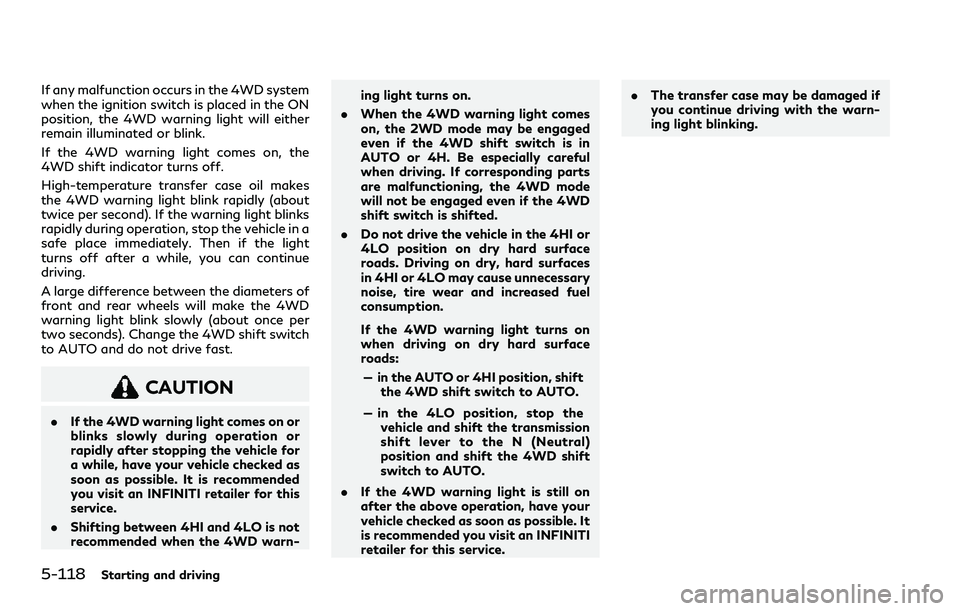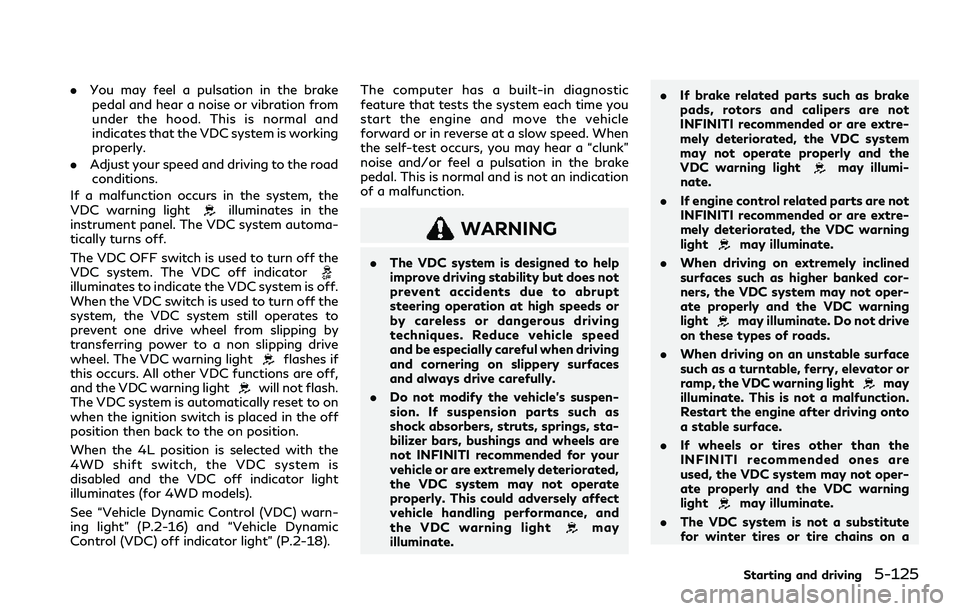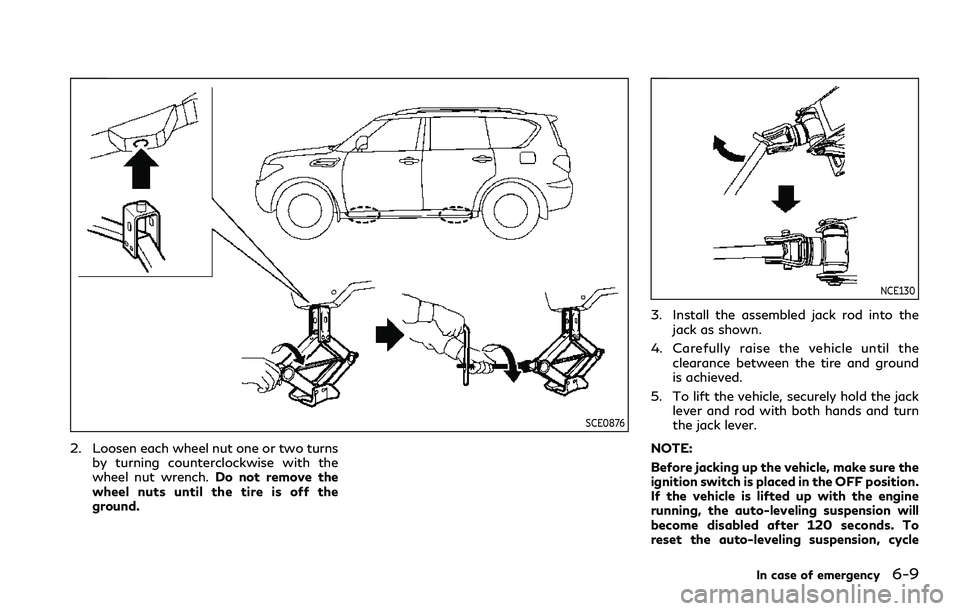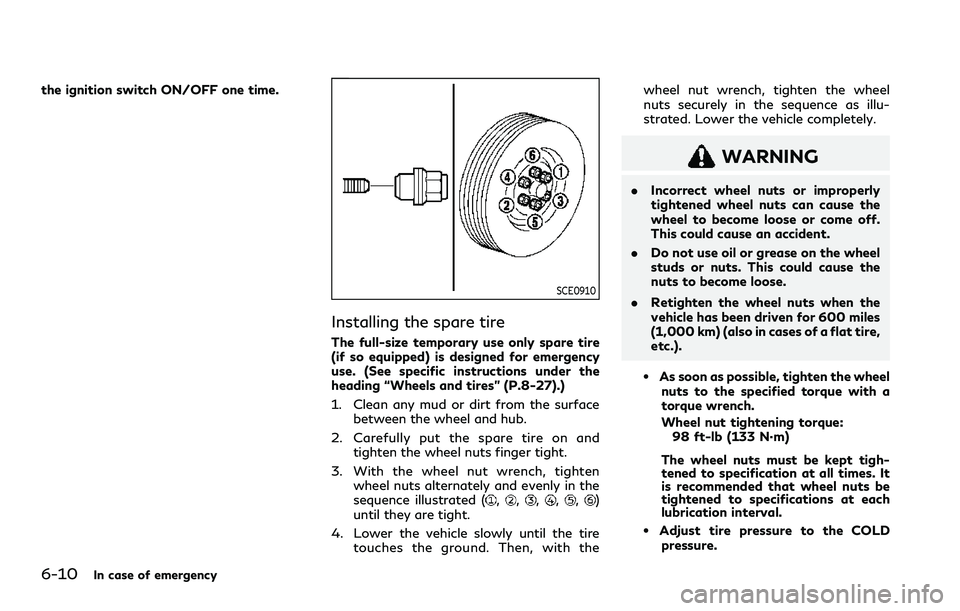ignition INFINITI QX80 2020 Manual Online
[x] Cancel search | Manufacturer: INFINITI, Model Year: 2020, Model line: QX80, Model: INFINITI QX80 2020Pages: 516, PDF Size: 1.89 MB
Page 334 of 516

5-80Starting and driving
WAF0313X
Operating conventional (fixed
speed) cruise control mode
To turn on the conventional (fixed speed)
cruise control mode,push and hold the
MAIN switch
for longer than about 1.5
seconds.
When pushing the MAIN switch on, the
conventional (fixed speed) cruise control
mode display and indicators are displayed
on the vehicle information display. After you
hold the MAIN switch on for longer than
about 1.5 seconds, the ICC system display
goes out. The cruise indicator stays lit. You
can now set your desired cruising speed.
Pushing the MAIN switch again will turn the system completely off.
When the ignition switch is pushed to the
OFF position, the system is also automati-
cally turned off.
To use the ICC system again, quickly push
and release the MAIN switch (vehicle-to-
vehicle distance control mode) or push and
hold it (conventional cruise control mode)
again to turn it on.
When the Distance Control Assist (DCA)
system is on, the conventional (fixed speed)
cruise control mode cannot be turned on
even though the MAIN switch is pushed and
held.
To turn on the conventional (fixed speed)
cruise control mode, turn off the DCA
system. See “Distance Control Assist
(DCA)” (P.5-82).CAUTION
To avoid accidentally engaging cruise
control, make sure to turn the MAIN
switch off when not using the ICC
system.
WAF0314X
To set cruising speed,
accelerate your
vehicle to the desired speed, push the
COAST/SET switch and release it. (The
color of the cruise indicator changes to
green and set vehicle speed indicator comes
on.) Take your foot off the accelerator pedal.
Your vehicle will maintain the set speed.
. To pass another vehicle, depress the
accelerator pedal. When you release the
pedal, the vehicle will return to the
previously set speed.
. The vehicle may not maintain the set
speed when going up or down steep hills.
If this happens, manually maintain vehi-
cle speed.
Page 370 of 516

5-116Starting and driving
.If the vehicle is stuck deep in mud, tire
chains may be effective.
CAUTION
. Do not spin the tires excessively.
Tires will sink deep into the mud,
making it difficult to free the vehicle.
. Avoid shifting gears with the engine
running at high speeds as this may
cause malfunction.
SSD1048
4WD SHIFT SWITCH
.Shift the 4WD shift switch to either the
AUTO, 4H or 4L position, depending on
driving conditions.
. With the switch set to the AUTO posi-
tion, distribution of torque to the front
and rear wheels changes automatically,
depending on road conditions encoun-
tered [ratio; 0 : 100 (2WD) ?50 : 50
(4WD)]. This results in improved driving
stability.
. When the vehicle is stopped after mak-
ing a turn, you may feel a slight jolt after
the shift lever is shifted to N (Neutral) or
P (Park) position. This occurs because
the transfer clutch is released and not because of a malfunction.
CAUTION
.
When driving straight, shift the 4WD
shift switch to the AUTO or 4H
position. Do not move the 4WD shift
switch when making a turn or rever-
sing. If the 4WD shift switch is
operated while making a turn, accel-
erating or decelerating or if the
ignition switch is placed in the OFF
position while in the AUTO, 4H or 4L,
you may feel a jolt. This is not a
malfunction.
. Do not shift the 4WD shift switch
while driving on steep downhill
grades. Use the engine brake and
low automatic transmission gears
for engine braking.
. Do not operate the 4WD shift switch
with the rear wheels spinning.
. Before placing the 4WD shift switch
in the 4H position from AUTO,
ensure the vehicle speed is less than
62 MPH (100 km/h). Failure to do so
can damage the 4WD system.
. Never shift the 4WD shift switch
between 4L and 4H while driving.
Page 371 of 516

.Engine idling speed is high while
warming up the engine. Be especially
careful when starting or driving on
slippery surfaces with the 4WD shift
switch in AUTO.
WAF0362X
4WD shift indicator
4WD SHIFT INDICATOR
The 4WD shift indicator is displayed in the
vehicle information display.
The indicator should turn off within a few
seconds after placing the ignition switch in
the ON position.
While the engine is running, the 4WD shift
indicator will illuminate the position selected
by the 4WD shift switch. (See the 4WD shift
procedure list shown in the “INFINITI all-
mode 4WD
®system” (P.5-112).) .
The 4WD shift indicator may blink while
shifting from one drive mode to the
other. When the shifting is completed,
the 4WD shift indicator will come on. If
the indicator does not come on immedi-
ately, make sure the area around the
vehicle is safe, and drive the vehicle
straight, accelerate or decelerate or
move the vehicle in reverse, then shift
the 4WD shift switch.
. If the 4WD warning light comes on, the
4WD shift indicator turns off.
4WD WARNING LIGHT
Warning light Comes on or
blinks when:
Illuminates There is a mal-
function in the 4WD system
Blinks rapidly The transfer case
oil temperature is
abnormally high
Blinks slowly The difference in
wheel rotation is
large
The 4WD warning light is located in the
meter.
The 4WD warning light comes on when the
ignition switch is placed in the ON position.
It turns off soon after the engine is started.
Starting and driving5-117
Page 372 of 516

5-118Starting and driving
If any malfunction occurs in the 4WD system
when the ignition switch is placed in the ON
position, the 4WD warning light will either
remain illuminated or blink.
If the 4WD warning light comes on, the
4WD shift indicator turns off.
High-temperature transfer case oil makes
the 4WD warning light blink rapidly (about
twice per second). If the warning light blinks
rapidly during operation, stop the vehicle in a
safe place immediately. Then if the light
turns off after a while, you can continue
driving.
A large difference between the diameters of
front and rear wheels will make the 4WD
warning light blink slowly (about once per
two seconds). Change the 4WD shift switch
to AUTO and do not drive fast.
CAUTION
.If the 4WD warning light comes on or
blinks slowly during operation or
rapidly after stopping the vehicle for
a while, have your vehicle checked as
soon as possible. It is recommended
you visit an INFINITI retailer for this
service.
. Shifting between 4HI and 4LO is not
recommended when the 4WD warn- ing light turns on.
. When the 4WD warning light comes
on, the 2WD mode may be engaged
even if the 4WD shift switch is in
AUTO or 4H. Be especially careful
when driving. If corresponding parts
are malfunctioning, the 4WD mode
will not be engaged even if the 4WD
shift switch is shifted.
. Do not drive the vehicle in the 4HI or
4LO position on dry hard surface
roads. Driving on dry, hard surfaces
in 4HI or 4LO may cause unnecessary
noise, tire wear and increased fuel
consumption.
If the 4WD warning light turns on
when driving on dry hard surface
roads:
— in the AUTO or 4HI position, shift the 4WD shift switch to AUTO.
— in the 4LO position, stop the vehicle and shift the transmission
shift lever to the N (Neutral)
position and shift the 4WD shift
switch to AUTO.
. If the 4WD warning light is still on
after the above operation, have your
vehicle checked as soon as possible. It
is recommended you visit an INFINITI
retailer for this service. .
The transfer case may be damaged if
you continue driving with the warn-
ing light blinking.
Page 375 of 516

4. Push the ignition switch to the OFFposition.
SIC4474
The TOW mode should be used when pulling
a heavy trailer or hauling a heavy load.
Driving the vehicle in the TOW mode with
no trailer/load or light trailer/light load will
not cause any damage. However, fuel econ-
omy may be reduced, and the transmission/
engine driving characteristics may feel unu-
sual.
Push the TOW mode switch to activate
TOW mode. The indicator light on the TOW
mode switch illuminates when the TOW
mode is selected. Push the TOW mode
switch again to turn the TOW mode off.
TOW mode is automatically canceled when
the ignition switch is placed in the OFF
position.
SIC4454
For driving or starting the vehicle on snowy
roads or slippery areas, turn the SNOW
mode on.
To turn the SNOW mode on, push the
SNOW mode switch. The SNOW mode
indicator on the vehicle information display
will illuminate. When the SNOW mode is
activated, engine output is controlled to
avoid wheel spin.
To turn the SNOW mode off, push the
switch and the indicator will turn off. Turn
the SNOW mode off for normal driving and
fuel economy.
Starting and driving5-121
TOW MODE SNOW MODE
Page 379 of 516

.You may feel a pulsation in the brake
pedal and hear a noise or vibration from
under the hood. This is normal and
indicates that the VDC system is working
properly.
. Adjust your speed and driving to the road
conditions.
If a malfunction occurs in the system, the
VDC warning light
illuminates in the
instrument panel. The VDC system automa-
tically turns off.
The VDC OFF switch is used to turn off the
VDC system. The VDC off indicator
illuminates to indicate the VDC system is off.
When the VDC switch is used to turn off the
system, the VDC system still operates to
prevent one drive wheel from slipping by
transferring power to a non slipping drive
wheel. The VDC warning light
flashes if
this occurs. All other VDC functions are off,
and the VDC warning light
will not flash.
The VDC system is automatically reset to on
when the ignition switch is placed in the off
position then back to the on position.
When the 4L position is selected with the
4WD shift switch, the VDC system is
disabled and the VDC off indicator light
illuminates (for 4WD models).
See “Vehicle Dynamic Control (VDC) warn-
ing light” (P.2-16) and “Vehicle Dynamic
Control (VDC) off indicator light” (P.2-18). The computer has a built-in diagnostic
feature that tests the system each time you
start the engine and move the vehicle
forward or in reverse at a slow speed. When
the self-test occurs, you may hear a “clunk”
noise and/or feel a pulsation in the brake
pedal. This is normal and is not an indication
of a malfunction.
WARNING
.
The VDC system is designed to help
improve driving stability but does not
prevent accidents due to abrupt
steering operation at high speeds or
by careless or dangerous driving
techniques. Reduce vehicle speed
and be especially careful when driving
and cornering on slippery surfaces
and always drive carefully.
. Do not modify the vehicle’s suspen-
sion. If suspension parts such as
shock absorbers, struts, springs, sta-
bilizer bars, bushings and wheels are
not INFINITI recommended for your
vehicle or are extremely deteriorated,
the VDC system may not operate
properly. This could adversely affect
vehicle handling performance, and
the VDC warning light
may
illuminate. .
If brake related parts such as brake
pads, rotors and calipers are not
INFINITI recommended or are extre-
mely deteriorated, the VDC system
may not operate properly and the
VDC warning light
may illumi-
nate.
. If engine control related parts are not
INFINITI recommended or are extre-
mely deteriorated, the VDC warning
light
may illuminate.
. When driving on extremely inclined
surfaces such as higher banked cor-
ners, the VDC system may not oper-
ate properly and the VDC warning
light
may illuminate. Do not drive
on these types of roads.
. When driving on an unstable surface
such as a turntable, ferry, elevator or
ramp, the VDC warning light
may
illuminate. This is not a malfunction.
Restart the engine after driving onto
a stable surface.
. If wheels or tires other than the
INFINITI recommended ones are
used, the VDC system may not oper-
ate properly and the VDC warning
light
may illuminate.
. The VDC system is not a substitute
for winter tires or tire chains on a
Starting and driving5-125
Page 384 of 516

6-2In case of emergency
SIC2574
Push the switch on to warn other drivers
when you must stop or park under emer-
gency conditions. All turn signal lights will
flash.
WARNING
.If stopping for an emergency, be sure
to move the vehicle well off the road.
. Do not use the hazard warning
flashers while moving on the highway
unless unusual circumstances force
you to drive so slowly that your
vehicle might become a hazard to
other traffic. .
Turn signals do not work when the
hazard warning flasher lights are on.
The flasher can be actuated with the ignition
switch in any position.
When an impact that could activate the
supplemental air bags is detected, the
hazard warning flasher lights blink automa-
tically. If the hazard warning flasher switch is
pushed twice, the hazard warning flashers
will turn off.
WARNING
Do not turn the hazard warning flasher
switch to off until you can make sure
that it is safe to do so. Also, the hazard
flasher warning may not blink automa-
tically depending on the force of impact.
Some state laws may prohibit the use of the
hazard warning flasher switch while driving. In the event of a roadside emergency,
Roadside Assistance Service is available to
you. Please refer to your Warranty Informa-
tion Booklet (U.S.) or Warranty & Roadside
Assistance Information Booklet (Canada) for
details.
HAZARD WARNING FLASHER SWITCHROADSIDE ASSISTANCE PROGRAM
Page 385 of 516

To shut off the engine in an emergency
situation while driving, perform the follow-
ing procedure:
.Rapidly push the push-button ignition
switch 3 consecutive times in less than
1.5 seconds, or
. Push and hold the push-button ignition
switch for more than 2 seconds.TIRE PRESSURE MONITORING
SYSTEM (TPMS)
This vehicle is equipped with the Tire
Pressure Monitoring System (TPMS). It
monitors tire pressure of all tires except the
spare. When the low tire pressure warning
light is lit and the “Tire Pressure Low Add
Air” warning appears in the vehicle informa-
tion display, one or more of your tires is
significantly under-inflated. If the vehicle is
being driven with low tire pressure, the
TPMS will activate and warn you of it by
the low tire pressure warning light. This
system will activate only when the vehicle is
driven at speeds above 16 MPH (25 km/h).
For more details, see “Warning lights, in-
dicator lights and audible reminders” (P.2-
11) and “Tire Pressure Monitoring System
(TPMS)” (P.5-5).
WARNING
. If the low tire pressure warning light
illuminates while driving, avoid sud-
den steering maneuvers or abrupt
braking, reduce vehicle speed, pull
off the road to a safe location and
stop the vehicle as soon as possible.
Driving with under-inflated tires may
permanently damage the tires and increase the likelihood of tire failure.
Serious vehicle damage could occur
and may lead to an accident and
could result in serious personal injury.
Check the tire pressure for all four
tires. Adjust the tire pressure to the
recommended COLD tire pressure
shown on the Tire and Loading
Information label to turn the low tire
pressure warning light OFF. If the
light still illuminates while driving
after adjusting the tire pressure, a
tire may be flat. If you have a flat tire,
replace it with a spare tire as soon as
possible.
. Since the spare tire is not equipped
with the TPMS, when a spare tire is
mounted or a wheel is replaced, the
TPMS will not function and the low
tire pressure warning light will flash
for approximately 1 minute. The light
will remain on after 1 minute. Have
your tires replaced and/or TPMS
system reset as soon as possible. It
is recommended you visit an INFINITI
retailer for these services.
. Replacing tires with those not origin-
ally specified by INFINITI could affect
the proper operation of the TPMS.
. Do not inject any tire liquid or aerosol
tire sealant into the tires, as this may
In case of emergency6-3
EMERGENCY ENGINE SHUT OFF FLAT TIRE
Page 391 of 516

SCE0876
2. Loosen each wheel nut one or two turnsby turning counterclockwise with the
wheel nut wrench. Do not remove the
wheel nuts until the tire is off the
ground.
NCE130
3. Install the assembled jack rod into the
jack as shown.
4. Carefully raise the vehicle until the clearance between the tire and ground
is achieved.
5. To lift the vehicle, securely hold the jack lever and rod with both hands and turn
the jack lever.
NOTE:
Before jacking up the vehicle, make sure the
ignition switch is placed in the OFF position.
If the vehicle is lifted up with the engine
running, the auto-leveling suspension will
become disabled after 120 seconds. To
reset the auto-leveling suspension, cycle
In case of emergency6-9
Page 392 of 516

6-10In case of emergency
the ignition switch ON/OFF one time.
SCE0910
Installing the spare tire
The full-size temporary use only spare tire
(if so equipped) is designed for emergency
use. (See specific instructions under the
heading “Wheels and tires” (P.8-27).)
1. Clean any mud or dirt from the surfacebetween the wheel and hub.
2. Carefully put the spare tire on and tighten the wheel nuts finger tight.
3. With the wheel nut wrench, tighten wheel nuts alternately and evenly in the
sequence illustrated (
,,,,,)
until they are tight.
4. Lower the vehicle slowly until the tire touches the ground. Then, with the wheel nut wrench, tighten the wheel
nuts securely in the sequence as illu-
strated. Lower the vehicle completely.
WARNING
.
Incorrect wheel nuts or improperly
tightened wheel nuts can cause the
wheel to become loose or come off.
This could cause an accident.
. Do not use oil or grease on the wheel
studs or nuts. This could cause the
nuts to become loose.
. Retighten the wheel nuts when the
vehicle has been driven for 600 miles
(1,000 km) (also in cases of a flat tire,
etc.).
.As soon as possible, tighten the wheel
nuts to the specified torque with a
torque wrench.
Wheel nut tightening torque: 98 ft-lb (133 N·m)
The wheel nuts must be kept tigh-
tened to specification at all times. It
is recommended that wheel nuts be
tightened to specifications at each
lubrication interval.
.Adjust tire pressure to the COLD pressure.